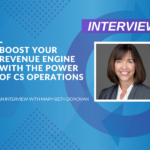Are You Measuring Customer Health Properly?
With the need to be increasingly customer-centric in a subscription-based world, many Customer Success leaders are left wondering: which customers should we focus more time on? What are the key improvement opportunities for our Customer Success (CS) strategy? Are there customers that can and should be more profitable? To answer these questions and assess the health of your customer base, you need a robust customer health scoring process and an up-to-date customer scorecard.
Customer scorecards are a vital mechanism for evaluating where your customers are, how they’re doing with your products, processes and teams and where they’re headed with your business. Unfortunately, some business leaders make the costly mistake of interchanging customer scorecards with lead scoring or business scorecards, or lack a customer health strategy altogether. When this happens, CS teams have to deal with limited actionable insights into customer and product engagement, time consuming processes and revenue retention challenges due to lagging indicators.
The good news is, it’s never too late to get started. Below, we’ve outlined a detailed action plan to help you build a customer scorecard that optimizes your health scoring strategy and drives higher customer value.
Start Simply
When done right, customer scorecards provide an actionable, repeatable and scalable framework for health scoring, a common dialect to measure a premium account’s health, transparency and confidence in reporting and increased customer retention. While these assets are vital to a high-performance CS organization, they don’t have to be complicated. There is a temptation to over-design and over-engineer scorecards based on the extensive amount of data you can measure but simple is often better, especially when you’re just beginning.
Once you create an elementary scorecard, you can test whether or not your scorecard reflects your customer’s reality and obtain periodic feedback to enhance it accordingly. It’s this simplicity that also means anyone on your team can create a customer scorecard. You don’t need to leverage data scientists or machine learning specialists right now; your current team can get started with a simple scorecard design and launch it within a CSM platform like Gainsight or even use a shared Google document, so long as they have access to directional data.
4 Expert-Trusted Categories To Include In Your Customer Scorecard
When it comes to creating customer scorecards, there’s one question we always get asked: what should I include on my customer scorecard? Every piece of data or information that you’re using on a day-to-day basis can help inform your scorecard and the subsequent feedback you gather can help you iterate on your scorecard over time.
We recommend including these 4 key categories when building out your customer scorecard:
1. Engagement Health
How is your customer engaging with your teams and your ecosystem? By collecting customer engagement data points, you can evaluate how your customers are responding to your team, strategy and roadmap and determine what needs to be improved. This includes factors such as your customer’s support ticket volume, visit frequency and the general “gut check” you get from your Customer Success Managers (CSMs), also known as CS sentiment or CS perspective.
Some key questions to consider when evaluating your customer’s engagement health:
- Do they open marketing emails? Do they click?
- Do they respond to CSM or digital outreach?
- Are they engaging with support?
2. Product Usage & Adoption
Product usage metrics reveal the relationship that your customer has with your product. By capturing day-to-day information about how your customer uses your product, how often and for how long, you can shape your actions to increase their overall experience and maximize value realization.
Once you have a strong understanding of usage, you can measure your customers’ adoption of your product to identify whether or not your product is actually providing value. Metrics such as Adoption Rate and Time To First [Key Action] are extremely helpful for large-scale data analysis of the user experience.
When you’re assessing your customer’s product usage and adoption, ask yourself:
- Are my customers engaging in ways that align with their use case?
- Are they using the most recent version of our product?
- Do my customers engage in ways that are appropriate for their lifecycle stage?
3. Lifecycle Stage
Lifecycle metrics help you understand where the customer is on their journey with your company and how they’re progressing in comparison to other customers. These metrics relate to how tenured your customer is.
To identify where your customers are in their journey, consider the following questions:
- Was their onboarding bumpy or slow?
- Do they continue to use “future speak”, describing the ways they want to use your product next?
- Have they expressed interest in providing case studies or speaking at a conference?
4. Customer Value & Customer Perception
While the aforementioned metrics form the foundation of an insightful customer scorecard, there’s no substitute for direct feedback from the customer. Conduct surveys and Executive Business Reviews (EBRs) to obtain a firsthand assessment from your customers about the value they’re getting (or not getting) from your people, processes and products. From there, you can determine what your team needs to be doing in order to continuously meet or otherwise adjust your customers’ needs and expectations.
When determining if your customers are receiving value from your product, think about the following:
- Have they progressed in their Adoption / Customer Success Plan?
- Are they able to speak to their progress with their leadership?
- Are they providing high CSAT / NPS survey results?
Pro Tip: The most important facets of an effective customer scorecard are visibility and accessibility so that everyone can understand, evaluate and benefit from the data. Make sure you include a rubric for each score within your scorecard so that each team member can see exactly what the score consists of and how it can be improved.
Use Your Customer Health Scoring To Create Meaningful Reporting Dashboards
With your customer scorecard ready to go, you need to make sure you’re leveraging its data to the fullest. A single scorecard on its own can only provide so much information and has limited actionable capabilities. In addition, we recommend aggregating all of your customer scorecards to create the following reporting views:
- Entire Book of Business: Provides Senior leadership with a holistic view of all of their CSMs’ books of business by score
- Score in Arrears: Consolidates the various scores periodically so that you can see how your score has fluctuated over time
- Future Looking: Gathers various key metrics about your customers into a single dashboard so that you can determine how your customers are doing and where there are opportunities and risks so that you can get ahead
Create A Data-Driven Customer Experience
Developing an impactful customer scorecard is not an overnight exercise. While you can start simply and easily, you need to constantly update, improve and iterate upon the scorecard to ensure it fully reflects your customers’ reality and provides meaningful and actionable data-driven insights.
Do you know if your current customer health scoring process is actually providing value to your teams and your customers? To find out, run it through the operational improvement cycle from our latest article to optimize your process for maximum impact.






